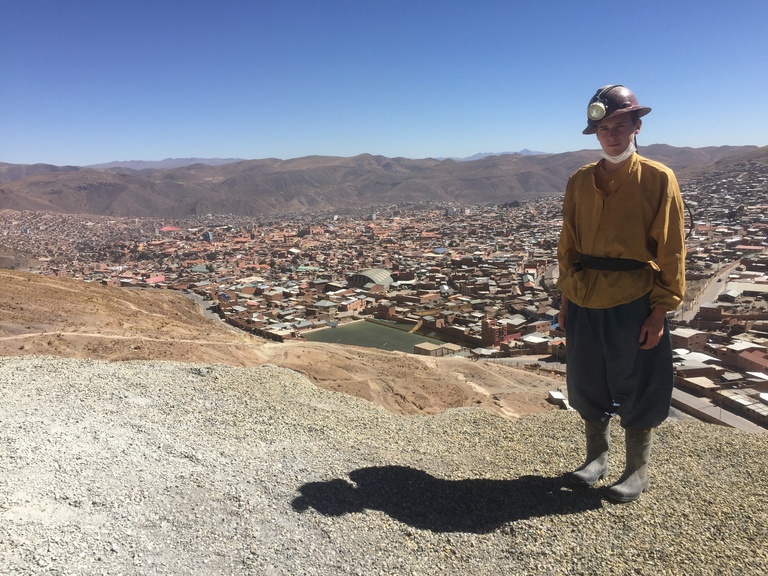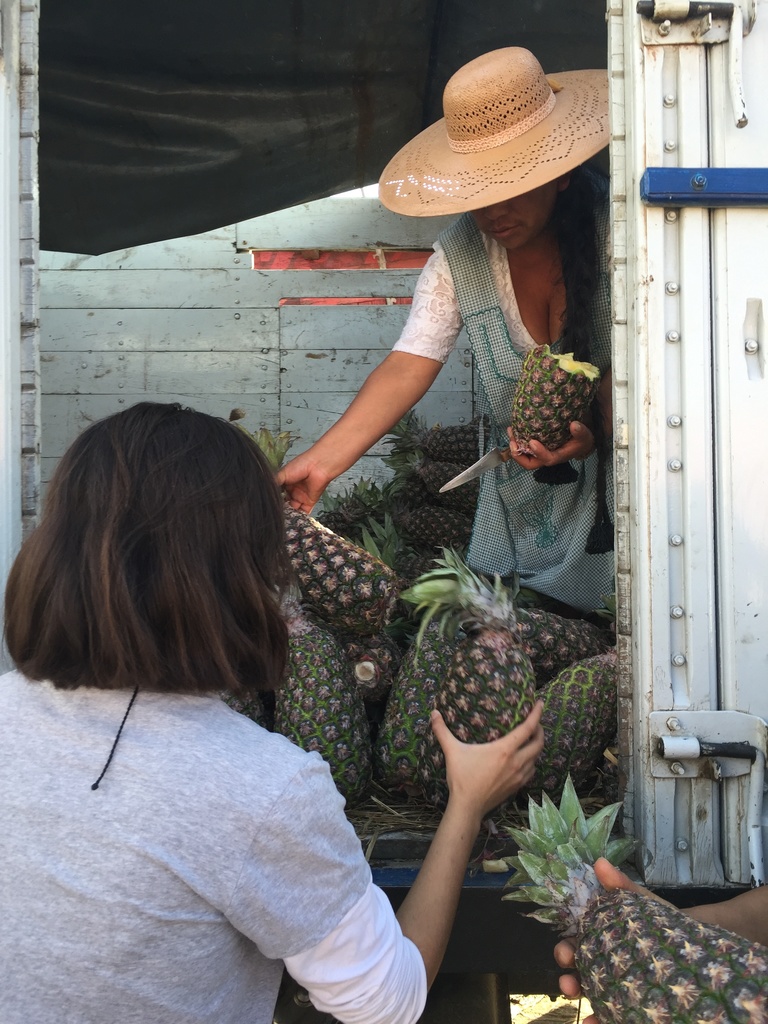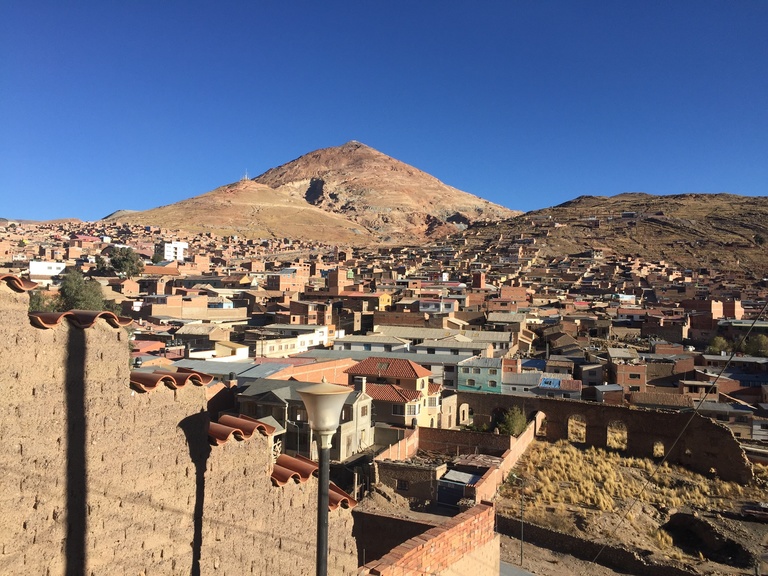By Alex Bare*

I know I promised to deliver a blog about my classes this week, but consider that cancelled for the moment.
Instead, I feel it is necessary to discuss my past week in Potosí. I’m fortunate to be studying here on a program that takes us to 6 major cities of Bolivia and even into parts of the countryside. I was not, however, mentally prepared for Potosí.
Potosí is the Mississippi of Bolivia. Ranking last out of Bolivia’s 9 departments in life expectancy, literacy, and nearly every other wellbeing indicator, it’s no surprise that many Bolivians look down upon the region. Despite this, the city of Potosí towers above the world at 13,400 feet. The only higher city in the world is El Alto, Bolivia. Altitude sickness is debilitating for many visitors, although the thin air is made a bit thicker by clouds of dust in this drought.
It is not a simple task to grasp that this was once the 3rd largest city in the world. At its height, Potosí supplied half of the world’s silver, funded the Spanish Empire for 2 centuries, and inflated the silver market so much that it bankrupted economies. In fact, the modern dollar sign ($) is a simplification of the letters P-T-S-Í superimposed over one another. Potosí literally gave the world the dollar sign, yet today is the most underdeveloped department in the most underdeveloped country in South America.

How could this be? How could a city that birthed many of the world’s first millionaires remain utterly neglected? To begin to answer that question, one only has to look into a history of greed and exploitation.
If the history of human bondage were encapsulated in a single empire of suffering, Potosí was its capital. In the decades following the discovery of veins of pure silver at Potosí, Quechua-speaking inhabitants of the region were enslaved to mine it from a mountain just outside the city known as Cerro Rico. Spanish colonial authorities had never been closer to a real life El Dorado. When indigenous slaves proved too belligerent and died in massive number, thousands more were imported from Africa. Many of them too died almost immediately in the harsh climate and altitude to which they were not accustomed. Estimates on the number of indigenous and African slaves who died in the mines of Cerro Rico range between 5 and 6 million.
In Potosí, our study abroad program arranged a tour of the mines where as many as 15,000 mostly Quechua-speaking men continue to work. As we put on our mining gear and headlamps, the meaning of this didn’t hit me. Even 1-kilometer deep, where we could feel explosives detonating in a nearby mine, I still did not grasp what it meant to be in such a place.
It wasn’t until our post-visit debriefing that I finally grasped the truth of what I had witnessed. When the only Latina student in the program talked about the pain of watching people who looked like her own cousins labor in the mine. When our program aide told us she doesn’t enter the mines anymore because she can’t bear to watch her own people suffer. When our program coordinator broke down as she described the immense respect she has for the miners who will probably not live past 45.
Never in my life had a been more acutely aware of my privilege. Never before had I felt such shame for the photos I took in the mine. Never before had I found myself in such a problematic position, or felt so uncomfortable in this country.
I felt pure disgust that my program had paid a tour company to take us into the heart of a mountain where millions had died and thousands more continue to toil under their jefes for little more than $275 a month. It felt immoral on so many levels. At the same time, my tour guide was a former miner who uses the tourist industry as an escape from the mine. Others consider tourist dollars vital to their community. There is no clear-cut answer to this question, no option free of criticism.
I also came to realize that our program director wanted us to feel uncomfortable. She wanted to force us out of the middle-upper class bubble of our lives in Cochabamba. Many of my friends in the program live in nothing short of mansions and penthouses in neighborhoods like Cala Cala and Los Cuadros. Here, jagged glass shards top the eight-foot walls of elegant chalets, threatening to scoop out the kneecaps of unwanted visitors.
Meanwhile in Potosí, wealthy cooperative bosses continue to profit off exploitive practices while darker-skinned workers toil in the mines. The Bolivian Government provides no compensation to miner’s widows. With parental consent, it remains legal for children as young as 12 to work in the mines. There is a new widow at Cerro Rico every 14 days.

At the 9/11 Memorial and the Holocaust Museum, you are expected to be shook to the core. There are tissues if you need them. At the mines of Potosí, no one asks you to be horrified. Nobody says, “never again, never forget.” That’s what makes it so innately disturbing.
The modern reality of the mines at Potosí is grim and deeply affected me. More than ever before, I am conscious of my privilege as a white, United States citizen studying in Latin America. I threw away the “souvenir rock” a miner gave me in the hotel bathroom. I deleted the photos I took in the mine when I got home. I will, however, take away an ever important reminder of my privilege from this experience.
Word of the Week
Campesino (adjective, noun):
- Of or relating to someone or something from the countryside
- A farmer or peasant
Why It’s Important
This word carries a different meaning in Bolivia. After centuries of laws that relegated indigenous people to the countryside, campesino has become synonymous with someone of indigenous descent. Even people who live in cities but wear polleras, put their hair in long braids, and speak an indigenous language are considered campesinos. Even in the vocabulary of this country, racial divisions run deep.
*Alex Bare is studying International Relations and minoring in Spanish at the University of Iowa. The Walcott, Iowa, native is spending his semester in Bolivia, with a focus on Multiculturalism, Globalization and Social Change.
Student blog entries posted to this International Accents page may not reflect the opinions and recommendations of UI Study Abroad and International Programs. The blog is intended to give students a forum for free expression of thoughts and experiences abroad in a respectful space.